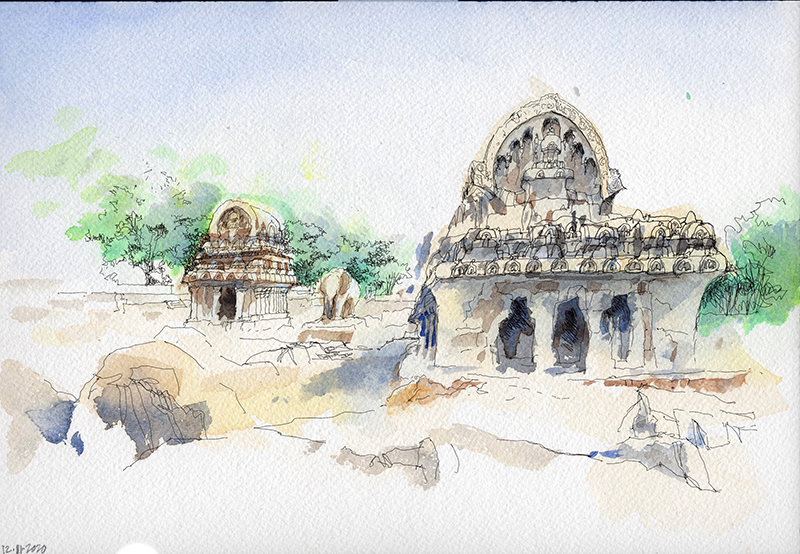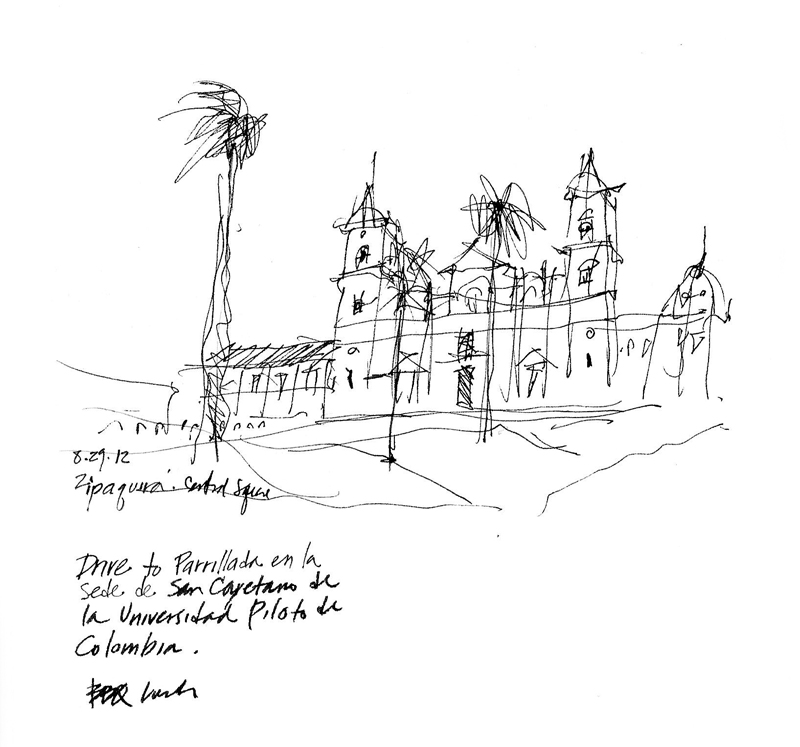
We can see the light at the end of the tunnel!!! As the winter solstice passes and the days slowly but surely get longer, we look forward to 2021. Happy Holidays to one and all…And Best Wishes in the New Year.


We can see the light at the end of the tunnel!!! As the winter solstice passes and the days slowly but surely get longer, we look forward to 2021. Happy Holidays to one and all…And Best Wishes in the New Year.

Another pandemic-induced hybrid sketch, this time of the Five Rathas site at Mahabalipuram, on the coast of the Bay of Bengal, in Tamil Nadu state, India. The complex, built in the 7th century during the reign of King Narasimhavarman I, comprises fine examples of Indian rock-cut architecture. Each ratha (chariot) is carved from a single granite monolith. The above view shows the Bhima Ratha on the right, the Nakula Sahadeva Ratha back and toward the left, with a full-size elephant sculpture in between.

This is another view drawn on site during my visit to Chennai in 2015. The Five Rathas was declared a UNESCO World Heritage Site in 1984.

The combined effects of the ongoing pandemic and current cold, rainy weather have made it increasingly difficult to leave the home office to go out to draw. So it’s a good time to explore new ways of working. Just as with the portrait of Istanbul posted previously, this familiar view of the Pantheon in the historic center of Rome was created through a hybrid process involving a watercolor underpainting, scanned and imported onto my iPad, and using the Procreate app to draw over the watercolor image.

Keep in mind that using a photograph as a reference is very much different from drawing on location, from direct observation. A photograph captures a moment in time and reflects the processing that flattens out three-dimensional data onto a two-dimensional surface. A drawing done on location, such as the view above, takes longer to execute and involves our senses, especially that of active seeing.
But in both cases, like a conversation, we do not know precisely where the drawing or painting process will lead. Even though we may have an objective in mind when we begin to draw, the sketch itself takes on a life of its own as it evolves on paper and we have to be open to the possibilities the emerging image suggests.

A view of Istanbul inspired by Ara Güler’s photographs that document the multilayered life of Istanbul from the 1940s to the 1980s, as well as my own memories of visits to that historic city that bridges east and west.


A brief word on process: First, a watercolor splash of Istanbul’s memorable skyline punctuated by her mosques and minarets. Then, a scan imported into Procreate on the iPad. Next, several attempts at foregrounding a hint of the steamers and smaller fishing boars that ply the Bosphorus.

During a conference in Bogotá in 2012, we took a bus tour of the city, which made it difficult to stop for any length of time to draw. However, as we drove around the Plaza Bolívar, I managed to sketch this plan perspective of Plaza Bolívar urban space. If you look at a satellite photo of the plaza, you will see that I greatly exaggerated its length, which illustrates how one’s perception of horizontal dimensions are subject to severe distortion and are difficult to capture in a drawing.

While the bus dropped us off on one corner of the square and drove around to pick us up at the opposite corner, I managed to also sketch this view of the cathedral, noting the way the slope of the square was integrated by mounding the brick pavement around the palm trees.

From 2013, a whimsical line drawing of a whimsical collection of chairs in a tree, located on North 35th Street, between Phinney and Evanston Avenue North. I walk past this tree daily but sadly, yesterday, I noticed that the tree had been cut down and removed. Another loss in the neighborhood

Opening in 1917, the Fremont Bridge crosses the Lake Washington Ship Canal and connects the Fremont and Queen Anne neighborhoods. In 2005, the bridge underwent a major overhaul to renovate its mechanical and electrical systems. Remnants of this renovation, such as these gears, are scattered around the Fremont neighborhood.
Unlike most of my urban sketches, this is a pure contour drawing, which involves working part to part, and requires careful observation and deliberate line work.

This view shows State Highway 20 approaching from the southwest and turning southeast through the middle of Winthrop, a small town at the confluence of the Methow and Chewuch rivers in the Methow Valley. While the town’s first postmaster, Guy Waring, is considered to be its founding father, the town is actually named after Theodore Winthrop, a 19th-century author who explored the Northwest in the 1850s.
What is striking about Winthrop’s main street is the Old West theme of the storefronts, the result of a westernization program that began in 1972 as Highway 20 through the North Cascades was nearing completion. Designed by architect Robert Jorgenson to promote tourism, the restoration was funded by local merchants along with a generous grant from lumber mill owners Kathryn and Otto Wagner.

In 2008, Yapı-Endüstri Merkezi (YEM) gave me the opportunity to offer a drawing workshop for Turkish students in Istanbul. After the two-day event, Dr. Meral Erdoǧan and Dr. Fulya Ozsel Akipek of Yildiz Technical University invited me to tour the Florya Atatürk Marine Mansion, summer residence of Mustafa Kemal Atatürk, founding father of the Republic of Turkey. Located along the shore of the Sea of Marmara, the Bauhaus style structure was designed by architect Seyfi Arkan and built in 1935. These quick sketches reflect a study of the design’s zoning and orientation to both shore and sea.

Continuing my series of drawings of Seattle Public Branch Libraries, this is the Magnolia Branch, designed by Paul Hayden Kirk of Kirk, Wallace, McKinley and Associates. Opening in 1964, it is located just outside the Magnolia Village business district. The American Library Association granted its Award of Excellence to the open timber structure, which incorporated an old madrona tree that grew on the site.
The Seattle Landmarks Preservation Board declared the Magnolia Branch a landmark building in 2001, after which the library and community developed plans to upgrade the existing structure while preserving its original design. SHKS Architects and the structural engineering firm of Swenson Say Fagét designed the 1400-square-foot addition, which housed a new meeting room and incorporated a new roof, upgraded mechanical systems, improved computer technology, and energy-efficient windows. The branch reopened on July 12, 2008.
In 2009, the library project’s team was given the Stewardship of Public Buildings award for “creating a model preservation project that incorporated both the restoration of a mid-century resource and the construction of a sensitive new addition that will allow the building to function as a library for years to come. In 2011, the expansion and renovation received further recognition with an honor award from the Washington Council of the AIA.